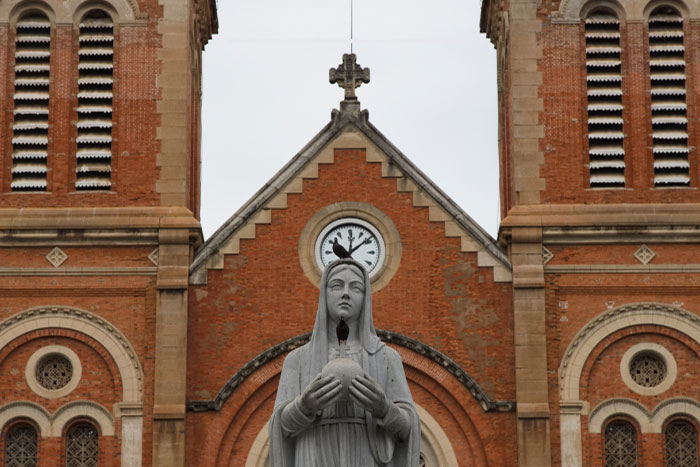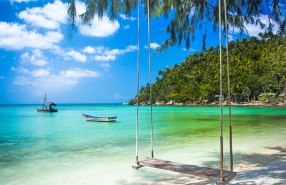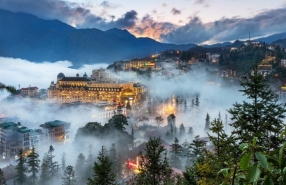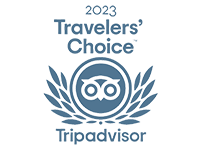
Welcome to the Saigon Notre-Dame Cathedral, a magnificent architectural gem and a symbol of Catholicism in Vietnam. This iconic landmark, also known as Notre-Dame Saigon, enchants visitors with its stunning design and rich history. Step inside to admire the intricate details, breathtaking stained glass windows, and a serene atmosphere that invites reflection and reverence. Join me on a journey to discover the cultural and spiritual significance of this renowned destination among What to do in Ho Chi Minh City.
1. What is the Saigon Notre-Dame Cathedral
The Saigon Notre-Dame Cathedral, also known as the Immaculate Conception Cathedral Basilica, is a renowned destination in Ho Chi Minh City, Vietnam. As the main cathedral of the Archdiocese of Saigon, it holds great significance for the Catholic community in the country. This architectural masterpiece, originally called the Saigon Church, is a unique and captivating landmark. With its rich history, stunning design, and spiritual ambiance, the cathedral draws visitors from around the world. It serves as a place of worship, hosts important religious ceremonies, and stands as a symbol of faith and cultural heritage in Vietnam.
2. The history of Saigon Notre-Dame Cathedral
a. The first church
Shortly after the capture of Saigon, the French colonialists established a temporary church for conducting Catholic Masses. The first church was built on Street No. 5 (now known as Ngo Duc Ke Street). Bishop Lefevre made the decision to construct a proper church, as the initial one was too small. In 1863, Admiral Victor Auguste Duperré decided to start construction on a new wooden church at a different location, near the "Grand Canal" (also known as Kinh Charner, which later became the site of the Republic of Vietnam's Court of Appeals and currently corresponds to the Sun Wah building).
Under the leadership of Bishop Lefebvre, the foundation stone for the new church was laid on March 28, 1863. The wooden church, initially called Saigon Church, was completed in 1865. However, due to significant damage caused by wood-boring insects such as termites and woodworms, religious ceremonies were held in the intimate setting of the former Governor's Palace, which later transformed into the Lasan Taberd school, until the construction of the grand cathedral was finished.
b. The second church
In August 1876, during the French colonial era, Governor Duperré of Cochinchina organized a design competition for the new cathedral. Out of 17 different design proposals, the design by architect J. Bourard, which combined Romanesque and Gothic architectural styles, was chosen. Initially, three locations were proposed for the construction:
The former Truong Thi foundation (now the corner of Le Duan and Hai Ba Trung Streets, where the French Consulate is located).
The Grand Canal area (at the site of the old church, now on Nguyen Hue Street).
The current location.
Eventually, the current location was selected. Once the design proposal was chosen, Admiral Duperré initiated the construction bidding process, and the same architect, J. Bourard, won the contract and directly supervised the project. All the materials, from cement and iron to screws, were imported from France. Notably, the exterior of the building was made with a special type of brick manufactured in Toulouse, France, which has retained its vibrant pink color without the need for plaster or moss removal.
On October 7, 1877, Bishop Isidore Colombert placed the first stone in front of the Lieutenant Governor of Cochinchina and other high-ranking officials of the time. The construction of the cathedral took three years. The consecration and dedication ceremony, organized by Bishop Colombert, took place on Easter Sunday, April 11, 1880, with the presence of Governor Le Myre de Vilers. Today, above the entrance doors of the cathedral, there is a marble plaque in the transept corridor that indicates the commencement and completion dates of the construction, as well as the name of the architect. The entire construction and interior decoration costs were covered by the Cochinchina Governorate, amounting to 2,500,000 French francs at the exchange rate of that time.
Originally known as the "State Church," the cathedral was initially funded and managed by the French government. In 1895, two bell towers were added to the cathedral, each standing at 57.6 meters tall and housing six large bronze bells. At the top of each tower, a 3.50-meter tall, 2-meter wide, and 600 kg heavy Cross was installed. The overall height of the cathedral, from the ground to the top of the Cross, measures 60.50 meters.
In the garden in front of the cathedral, in 1903, the French erected a bronze statue of Pigneau de Béhaine (also known as Bishop Ba Da Loc or Bishop Adran) holding the hand of Prince Canh (son of Emperor Gia Long). The monument consists of a circular red granite pedestal with a sculpted statue of Bishop Adran wearing Episcopal vestments and leading Prince Canh by his left hand. The statue, made of bronze and cast in France, was commonly referred to as the "two-figure statue" by the local population at that time, to distinguish it from the "single-figure statue," which was the statue of Admiral Genouilly located near the Me Linh Square (now at the end of Hai Ba Trung Street, near the Saigon River). In 1945, this statue was removed by the Vietnamese Imperial Government of Prime Minister Tran Trong Kim. However, the red granite pedestal remains in place without any statue placed on top of it.
c. The church with the name Notre Dame

Step back in time with me to the year 1958, a momentous period in Saigon's history. Father Giuse Phạm Văn Thiên, a respected figure in the Saigon Parish, embarked on a remarkable endeavor — the commissioning of a statue dedicated to the Virgin Mary, symbolizing peace. But this was no ordinary statue; it was a masterpiece carved from the finest white Carrara marble sourced all the way from the picturesque town of Pietrasanta, Italy, nestled 500 kilometers away from Rome.
After months of meticulous craftsmanship by skilled Italian artisans, the statue was ready to embark on its journey to Vietnam. On a crisp January day in 1959, it was carefully loaded onto the Oyanox ship, setting sail from the port of Genoa. The statue braved the vast seas, carrying with it the hopes and dreams of a nation longing for peace. Finally, on a momentous day in mid-February, the ship reached Saigon's shores, and the statue of the Virgin Mary was joyously welcomed by the locals.
Erected on a vacant stone pedestal that had stood empty since 1945, the statue found its rightful place in front of the church. Father Giuse, deeply touched by the significance of the moment, personally composed a prayer, "May the Virgin Mary bring peace to Vietnam." With dignitaries and faithful gathered around, he recited these heartfelt words, uniting the hopes and prayers of all who were present.
The following day, the atmosphere in Saigon reached a crescendo of excitement and anticipation. Cardinal Krikor Bedros XV Aghagianian, making a momentous journey from Rome, arrived to preside over the closing ceremony of the National Marian Congress. This distinguished figure, adorned in his cardinal robes, bestowed an aura of reverence upon the occasion. In the tranquil afternoon of February 17, 1959, the consecration of the statue took place under the watchful eyes of the Cardinal. It was a defining moment, forever transforming the church into the renowned Saigon Notre-Dame Cathedral, a symbol of faith and devotion.
The significance of this event did not go unnoticed by the Holy See. On December 5, 1959, the Cathedral Saigon was granted the honor of a consecration ceremony, and its status was elevated to that of a minor basilica. Since then, it has been officially known as the Saigon Notre-Dame Basilica, a testament to its importance within the Catholic Church.
Over the years, this magnificent cathedral has witnessed the ordination of numerous bishops, each adding their unique chapter to its storied history. From Jean Cassaigne in 1941 to Joseph Vũ Duy Thống in 2001, the cathedral stands as a testament to the spiritual journey of these revered individuals.
Today, as you step foot into the Notre-Dame Saigon Basilica, let your senses be captivated by the timeless beauty and profound history that permeate its hallowed halls. Marvel at the exquisite craftsmanship of the Virgin Mary statue, a symbol of peace and solace. Take a moment to reflect on the prayers offered by countless faithful over the years and the countless stories etched into the very fabric of this sacred place.
Saigon Notre-Dame Cathedral Basilica continues to stand as a beacon of faith and a testament to the enduring power of devotion. It is a sanctuary where the past intertwines with the present, inviting us to embrace the harmony and serenity that can be found within its sacred walls.
3. Some significance of the Saigon Notre-Dame Cathedral
a. The architecture
Saigon Notre-Dame Cathedral stands tall and proud, showcasing its remarkable architectural design and historical significance. This iconic religious structure, located in the heart of Saigon-Gia Dinh, boasts unique features that set it apart from other churches in the region. Let us delve into the captivating architecture and intricate details that make Saigon Notre-Dame Basilica a true marvel.
One of the most impressive aspects of the basilica is its robust foundation. The basement is ingeniously designed to withstand a load ten times the weight of the entire structure above it. This exceptional strength ensures the longevity and stability of the cathedral, even in the face of external forces.
Unlike many churches in the area, Notre-Dame Saigon breaks away from the traditional enclosed design. Surprisingly, it lacks the customary fences or walls that typically surround such places of worship. This openness creates a unique ambiance, inviting visitors to experience a sense of unity and connection with the divine.
Stepping inside the basilica, one is immediately struck by its spacious and meticulously planned interior. The main nave, flanked by two side aisles, leads to two rows of prayer rooms. With a total length of 93 meters and a width of 35 meters at its broadest point, the basilica provides ample space to accommodate up to 1,200 individuals.
The interior features two rows of rectangular main columns, symbolizing the twelve apostles. Each column is adorned with six statues representing the revered saints. The centerpiece of the basilica is the altar in the Holy Sanctuary, crafted from a single block of exquisite marble. Six intricately carved angels support the altar surface, while the base is divided into three sections, depicting sacred events through masterful sculptural artistry.
The walls of Saigon Cathedral are adorned with 56 captivating stained glass windows. These vibrant works of art depict characters and events from the Holy Bible. Among them are 31 circular rose windows and 25 multicolored stained glass windows, skillfully crafted to create breathtaking visual imagery. The careful attention to detail in the Romanesque and Gothic architectural styles adds an aura of solemnity and elegance to the basilica.
Above the main entrance, an awe-inspiring organ loft houses a magnificent pipe organ. This extraordinary instrument, one of the oldest in Vietnam, was meticulously handcrafted by foreign experts. Designed to produce sound that resonates through the entire basilica, the organ's impressive dimensions stand as a testament to its musical prowess and architectural significance.
b. The surrounding area
In front of the basilica lies a park known as Công trường Công xã Paris. This picturesque park, adorned with intersecting roads forming a cross shape, serves as a peaceful oasis amidst the urban landscape. As you explore this tranquil space, your gaze is drawn to a magnificent statue standing proudly at its center—the "Đức Mẹ Hòa bình" or "Mother of Peace," also known as the "Nữ vương Hòa bình" or "Queen of Peace."
Crafted by the skilled hands of G. Ciocchetti in 1959, this statue is a true masterpiece. Carved from white Italian marble, it stands tall at a height of 4.6 meters, weighing an impressive 8 tons. What makes this statue truly unique is its intentionally rough texture, carefully preserved to maintain the natural sculpted appearance. Every detail, from the delicate facial features to the flowing garments, is a testament to the artistry and devotion of its creator.
The statue depicts the Virgin Mary, standing upright with grace and serenity. In her left hand, she holds a globe, upon which a cross is affixed—a powerful symbol of hope and redemption. As you gaze into her eyes, uplifted towards the heavens, you can almost feel the weight of her prayers for peace resonating in the air. At her feet, a broken serpent lies, symbolizing the triumph of good over evil.
A bronze plaque, inscribed with Latin words, adorns a stone pedestal in front of the statue. It reads, "REGINA PACIS - ORA PRO NOBIS - XVII. II. MCMLIX," which translates to "Queen of Peace - Pray for Us - 17.02.1959." These words serve as a constant reminder of the statue's purpose—to inspire prayers and supplications for peace, not only in Vietnam but for the entire world.
4. Travel tips before your visit
If you're planning a visit to Notre-Dame Saigon, here are some travel tips to help make your experience enjoyable and memorable for What to do in Ho Chi Minh City:
Check the Opening Hours: Before heading to the basilica, make sure to check the opening hours. The cathedral is typically open for visitors during the day, but it's always a good idea to verify the current schedule to avoid any disappointment.
Dress Modestly: As a place of worship, it's important to dress respectfully when visiting Saigon Notre-Dame Basilica. Opt for clothing that covers your shoulders and knees, and avoid wearing revealing or inappropriate attire. This shows respect for the religious significance of the site.
Be Mindful of Religious Services: The basilica holds regular religious services and Masses. If you're visiting during these times, be mindful of the worshippers and maintain a quiet and respectful demeanor. It's best to avoid taking photographs or engaging in loud conversations during these moments.
Explore the Surrounding Area: Saigon Notre-Dame Basilica is located in a vibrant part of the city, offering plenty of other attractions to explore. Take some time to wander around the area and discover other landmarks, such as the Saigon Central Post Office and the Reunification Palace, which are within walking distance.
Capture the Beautiful Architecture: The basilica's stunning French Gothic architecture is a sight to behold. Don't forget to bring your camera or smartphone to capture the intricate details, the vibrant stained glass windows, and the majestic exterior. However, be respectful and follow any guidelines regarding photography within the church.
Visit during the Day: To fully appreciate the beauty of Saigon Notre-Dame Basilica, plan your visit during daylight hours. The natural light filtering through the stained glass windows adds a magical ambiance to the interior, allowing you to admire the architectural marvels and intricate artwork.
Respect the Sacred Space: Remember that Saigon Notre-Dame Basilica is a place of worship and reverence for many people. Keep noise levels low, refrain from touching or climbing on any religious artifacts or statues, and follow any specific instructions or guidelines provided by the staff or signs within the cathedral.
Learn the History: Take some time to familiarize yourself with the rich history and significance of the basilica before your visit. Understanding the background and events surrounding the construction of the cathedral will enhance your appreciation for its cultural and religious importance.
By following these travel tips, you can make the most of your visit to Saigon Notre-Dame Basilica and have a meaningful experience exploring this iconic landmark in Saigon.
5. Q&A - Some often asked question about the Saigon Notre-Dame Cathedral
Is Saigon Notre-Dame Basilica open to the public?
Can I take photographs inside the cathedral?
For What to do in Ho Chi Minh City, Can I attend a Mass or religious service at the basilica?
Yes, Saigon Notre-Dame Basilica holds regular Masses and religious services. If you would like to attend a service, check the schedule in advance to plan your visit accordingly. Remember to be respectful during these times.
By following these tips, you can make the most of your visit to
Saigon Notre-Dame Cathedral and enjoy all that this historic landmark has to offer. If an authentic trip to Saigon Notre-Dame Cathedral is what you are after, then don't hesitate to contact us : AUTOUR ASIA -
Vietnam Travel Agency to ensure you the voyage of your dream.












.jpg)

















